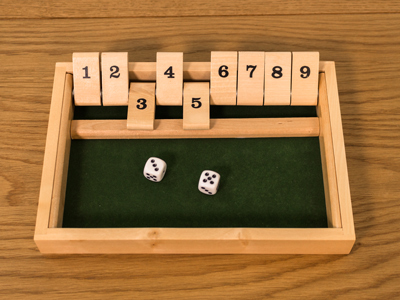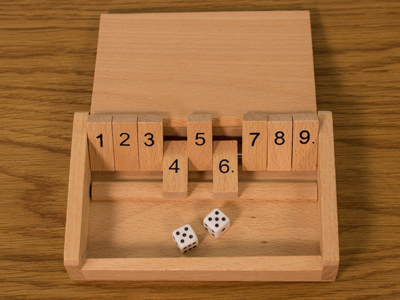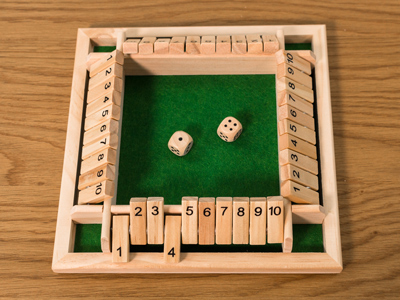Shut The Box
Don't hesitate to introduce this game to young children. It teaches counting in a fun way and, unlike many maths games, it has very few parts for tiny hands to lose.
Reasons to Choose the Shut the Box Game
- Great for assisting children in learning addition
- Suitable for two players, but any number can participate
- Easy-to-learn rules in just a few minutes
- Durable with only two pieces for young ones to misplace
- Available for under £10.00
LEARN ABOUT THE BENEFITS OF LEARNING THROUGH QUIZZES
Understanding the Rules
- Begin with all number blocks standing upright
- Objective: Knock over all the blocks
- Roll two dice
- Add the pips on the dice
- Knock over blocks matching the dice total
- Continue throwing dice and knocking over blocks
- Turn ends when dice total exceeds remaining standing blocks
- Add the numbers on standing blocks, noting the total
- Stand all number blocks upright for the next player
- Record the pips' value on standing blocks at each turn's end
- Player with the LOWEST score wins
- If a player knocks over all blocks, they can "Shut the Box" and win
Watch our video to get started in less than five minutes.
Educational Value of the Game
The game serves a dual educational purpose: reinforcing addition skills and fostering strategic thinking.
Deciding which numbers to knock over involves choice. For example, if the dice add up to 10, various number combinations can be knocked over, adding an element of excitement to the game.
Players may aim for high or low numbers, allowing children to observe and learn different strategies.
The game provides an invaluable way to retain the interest of children when they are taking their first tentative steps into the world of mathematics.
Why is it Inexpensive?
Due to its simplicity and lack of individual parts, "Shut the Box" is not subject to intellectual property rights, resulting in competitive pricing among manufacturers.
Unravelling the Game's History
The game's origin is uncertain; some claim 12th-century France, while others suggest 1900s Channel Islands.
FIND OUT WHY KIDS LOVE OUR WEBSITE
Diverse Versions Available
Amazon offers over a hundred versions, ranging from £6.00 to £25.00. Whether a basic set or a £100.00 black walnut version, the rules remain the same.
We reviewed three variants:
Imagin Toys Shut The Box Game (Cost £9.99)

This is the most usual size for the game – it measures approximately 25cm x 17cm.
The size is good for adult fingers to knock the numbers over without accidentally knocking two down.
Many manufacturers make almost identical, well-constructed games.
The one we bought and demonstrated in the video was manufactured by Imagin.
Shut the Box – Pocket Size from Toys Pure (Cost £5.95)

This really is pocket-sized, measuring only 14cm x 8cm. The one we trialled was nicely made although the dice are necessarily very small and may be a little difficult to handle by young children.
It can be slipped into a jacket pocket and played anywhere at any time.
At a cost of only £5.95 it gets our vote for being the best value.
Kitchnexus – 4 Player Shut the Box (Cost £13.99)

Like the other versions we trialled, this is very serviceable quality with little to go wrong.
The rules are slightly more difficult to explain because up to 4 players can be involved - but a comprehensive rule sheet is included with the product.
Oddly, the one we bought came securely wrapped in Clingfilm but without a box which makes it impossible to “Shut the Box”!
There is no reason why this version cannot be played with just two people but our suggestion is that you buy one of the cheaper versions (like the pocket-sized one above) to see if you enjoy it before buying this more expensive version.
A quick reminder: A subscription to Education Quizzes allows up to 6 children to play over 3,000 online quizzes and provides endless hours of entertainment for just £9.99 per month. Subscribe



